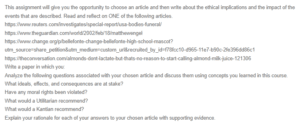Enterprise Risk Assessment, Audit, and Cyber law
Since the system is to be used in an Air Force base, there are significant risks that its information faces. Thanks to technological advancement, the Air Force currently collects its information on a massive and automated scale. Such information is sensitive and could jeopardize the safety and well-being of the base and the American citizens as a whole (Brockett, Golden, & Wolman, 2012). Control systems in the base, such as life safety, building automation, airfield control systems, and utility monitoring, are the most vulnerable areas to different cyber threats. It is only by identifying the control systems and infrastructure devices, mapping them, and understanding the risks and their potential impacts that the base can be significantly secured.
To ensure data security is observed, it is vital to have an accurate inventory of devices responsible for controlling the systems in question. When these control systems are accounted for, they can be used to ensure that the information passed through them is verified and only from authorized sources. These systems should also interface with the programming interfaces that exist and must constantly analyze and determine the overall base risk. Similarly, this technological stack must work with other Air Force bases regardless of their geographical location and age (Brockett, Golden, & Wolman, 2012). Therefore, although getting state-of-the-art equipment might appear beneficial to the project, it might end up being unable to work with the other bases, especially in times of emergencies.
The types of threats that the airbase is facing vary significantly, with attackers mostly being individuals who operate for their own benefit. These include people who want to steal the resources of the base or the military in general. Due to the large personnel outlay by the military, online scammers and fraudsters usually target the information of U.S. military members to perpetuate their criminal activities (Yannakogeorgos & Lowther, 2014). With such information, it becomes possible for them to have credibility, plausibility, and emotional appeal, whether dealing with the system or their families. Other threats, which are more significant, include those from other governments or equally large entities. These advanced threats might be able to invest not only time but also technological means that are unique and could be disastrous to the base or its members and their families.
For a typical Air Force base, among the components included in the system are laptops, desktops, printers, and cameras, including those for security and networking equipment. With these, there will be a need for a unique system that will manage these components effectively. Since these items need to be networked, the designed system should help identify these components, including the different points and the activities going on at each point (Antonucci, 2017). Because the military usually deals with transactions that are large and vital for security, the new system being installed should be able to handle any vulnerability and keep the different threats out of the system.
Different laws exist designed to help entities such as this Air Force base from certain attacks and misuse of information. One of the domestic laws applicable in such a case would be the Computer Fraud and Abuse Act (CFAA), which was the first domestic cybercrime law passed in 1984. Amongst the activities that this act prohibits include obtaining national security information without the right authorization and accessing the information of U.S. government agencies, financial institutions, and any other such protected computer. There is also the wiretap act that unauthorized the use of eavesdropping to gain information that is prohibited. Although this law was designed to serve in the era of wiretaps, today, anything that uses such tactics, such as the use of key-recording software, is prosecuted under these same laws.
References
Antonucci, D. (2017). The cyber risk handbook: Creating and measuring effective cybersecurity capabilities.
Brockett, P. L., Golden, L. L., & Wolman, W. (2012). Enterprise cyber risk management. Risk management for the future–Theory and cases, 319-340.
Yannakogeorgos, P. A., & Lowther, A. (2014). Conflict and cooperation in cyberspace: The challenge to national security. Boca Raton, FL: Taylor & Francis.
ORDER A PLAGIARISM-FREE PAPER HERE
We’ll write everything from scratch
Question

Article Review
Utilizing your comprehensive security plan outline as a guide, write the enterprise risk assessment, audit, and Cyberlaw.
I have attached the Week 1 Outline that is related to this project. Now, I need to make this portion of the project in relation to my subject from the first week. This is a combination of many weeks of the project to put together at the end of 8 weeks and become the entire project.
It is ok to add more details that may not be into the week one outline, as long as they are fit to the subject week 1.

